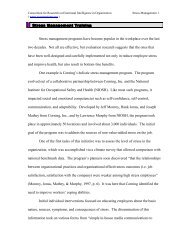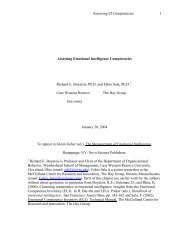Unleashing the Power of Self-Directed Learning (.pdf)
Unleashing the Power of Self-Directed Learning (.pdf)
Unleashing the Power of Self-Directed Learning (.pdf)
You also want an ePaper? Increase the reach of your titles
YUMPU automatically turns print PDFs into web optimized ePapers that Google loves.
Consortium for Research on Emotional Intelligence in Organizations<br />
www.eiconsortium.org<br />
<strong>Self</strong> <strong>Directed</strong> <strong>Learning</strong><br />
2<br />
The new economy is not about technology, it is about a change in <strong>the</strong> basic<br />
assumptions about <strong>the</strong> nature <strong>of</strong> work. Contributing to this are several demographic<br />
factors. Worldwide, <strong>the</strong> workforce is aging. By 2050, <strong>the</strong> average age <strong>of</strong> <strong>the</strong> US<br />
population will increase to 40 (from 36 in 1995). In <strong>the</strong> US in 1999, 19% <strong>of</strong> <strong>the</strong> workforce<br />
was 70 or older. By that same year, <strong>the</strong> number <strong>of</strong> retirees in Europe will be greater than<br />
<strong>the</strong> number <strong>of</strong> people in <strong>the</strong> workforce (The Economist, 2000). The workforce and<br />
population is becoming increasingly ethnically and racially diverse. By 2050, 24% <strong>of</strong> <strong>the</strong><br />
workforce (about 97 million people) in <strong>the</strong> US will be Hispanic. Women are filling more<br />
positions <strong>of</strong> power in organizations each year. Slowing population growth and<br />
resettlement patterns are changing <strong>the</strong> human resource picture in entire countries. For<br />
example, by 2050, without extraordinary immigrations, <strong>the</strong> population <strong>of</strong> Spain and Italy<br />
will shrink by 25%.<br />
Technology has changed <strong>the</strong> design <strong>of</strong> work and <strong>the</strong> rhythm <strong>of</strong> our lives. Even<br />
though we may feel guilty for not checking our email at least once a day, we still fail to<br />
comprehend <strong>the</strong> magnitude <strong>of</strong> this change. For example, <strong>the</strong> current high school<br />
graduating class in <strong>the</strong> US will be <strong>the</strong> first generation to never have touched a typewriter.<br />
Their basic assumptions about how to work, live and learn is different than ours as a result<br />
<strong>of</strong> technology. We engage in anywhere, anytime shopping, conversations, information<br />
acquisition, medical advice, and learning.<br />
At <strong>the</strong> same time, right-sizing, acquisitions, dot com exuberance, and changing<br />
values have led to a dramatically different relationship between each person and <strong>the</strong><br />
organizations within which <strong>the</strong>y work. People are more individualistic in <strong>the</strong> way <strong>the</strong>y






